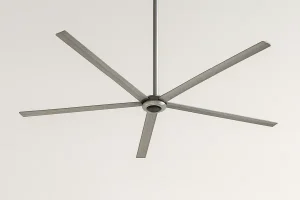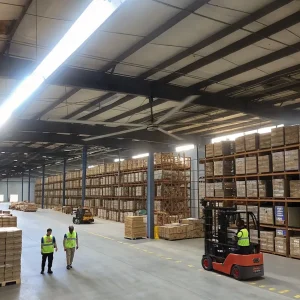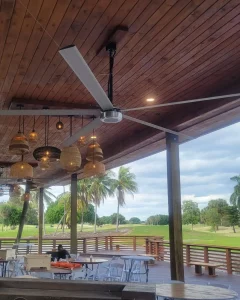Many factories, schools, and gyms suffer from heat buildup and stagnant air, undermining productivity and comfort. This situation can drive up energy bills and spark employee dissatisfaction. Yet a practical solution exists: installing an ventilatore industriale that efficiently manages flusso d'aria, stabilizes temperature, and cuts operational headaches in big indoor spaces.
SÌ, ventilatori industriali are absolutely worth it for large facilities. They move a lot of air a un bassa velocità yet still cool the air effectively and keep the environment stable. From magazzino floors to gyms, these fans help distribute aria fresca, cut down on energy expenses, and minimize the reliance on HVAC. The result is improved comfort, productivity, and risparmio energetico in a single, high-performing solution.

ventilatore hvl
UN ventilatore industriale is a specialized device built to spostare l'aria more effectively than standard fans. Unlike a simple electric fan at home, industrial fans are typically made with industrial-grade parts and materials designed for heavy usage. These fans are often used in grandi spazi—like factories, magazzini, sports arenas, or schools—to optimize flusso d'aria and maintain comfortable temperatures.
In professional settings, you’ll find industrial fans come in multiple shapes and sizes, from small portable units to huge overhead ventilatori da soffitto industriali. They’re generally powered by a robust motore, featuring strong pale del ventilatore that can stand continuous operation without overheating. Because industrial fans are made for more than quick cooling, they emphasize durability, efficienza energetica, and broad coverage.
Ventilatori industriali help businesses reduce reliance on Riscaldamento, ventilazione e condizionamento (HVAC) sistemi, saving money on power bills while producing a effetto rinfrescante. By generating movimento dell'aria, they disperse aria calda pockets, maintain uniform temperatures, and keep the air moving. This results in better overall qualità dell'aria, fewer respiratory complaints, and happier employees. Whether used in production lines or outdoor areas like covered pavilions, a well-chosen ventilatore industriale can make a big difference.
When discussing types of industrial fans, you quickly realize it’s not a one-size-fits-all scenario. Many industrial sites demand different models based on esigenze specifiche like size constraints, flusso d'aria demands, or the presence of dust or fumes.
Ventilatori a piantana can handle moderate tasks, but a specialized ventilatore hvl (High Volume Low Speed) might be more suitable for spazio industriale demands. The HVLS approach uses wide pale del ventilatore to move large amounts of air slowly, ensuring even temperatures. If your facility needs continuous, even distribution of aria fresca, an HVLS unit is typically the top choice.
If there’s one environment that benefits immensely from UN industrial warehouse fan, it’s precisely that—a magazzino. These buildings often have high ceilings, minimal airflow, and an urgent need to move air. By installing a powerful ventilatore industriale overhead, you create a steady circolazione dell'aria that prevents hot spots near the roof and temperature imbalances on the floor.
In a typical warehouse, inventory might stack to the rafters. Without enough movimento dell'aria, warm air can accumulate up high while ground-level employees endure cooler drafts. A well-chosen overhead fan solves this mismatch, helping maintain consistent climates, protecting products from temperature extremes, and keeping workers comfortable. This stable environment leads to fewer moisture-related issues and can even reduce the chance of mold or product spoilage.
(Case Study)
A 50,000 sq ft distribution center installed an industrial overhead fan with a piedi cubi rating of hundreds of thousands per minute. The result? Staff reported a more pleasant environment, and management noticed fewer workers complaining about temperature fluctuations—plus noticeable risparmio energetico on cooling bills.

Industrial Warehouse Fan for Large Footprints
UN grande ventilatore industriale typically features a alto volume bassa velocità approach, also known as HVLS. By spanning up to 24 feet in diameter, these fans move large amounts of air quietly and efficiently. They don’t just cool the air but help mix warm and aria più fresca layers, leading to an even temperature from livello del pavimento to ceiling.
Utilizzando ventilatori industriali in expansive environments fosters a comfortable atmosphere. Employees feel less fatigue, leading to better focus and fewer breaks to handle heat stress. The consistent flusso d'aria also helps carry away any airborne particles, improving overall qualità dell'aria and potentially reducing respiratory irritations. If you run a fitness center or a manufacturing line, this gentle breeze approach can be transformative.
(Table: Large Fan vs. Multiple Small Fans)
| Fattore | One Large Fan | Multiple Small Fans |
|---|---|---|
| Installazione | Fewer units to mount | May require complicated setups |
| Air Distribution | Uniform coverage across large area | Potential uneven cooling |
| Consumo energetico | Usually lower total draw | Summation of multiple smaller motors |
| Manutenzione | Single system to inspect | Each fan needs individual checks |
UN ventilatore da pavimento is a portable device you place on the ground or a stand to direct air where you need it. They come in different sizes, from small box designs to bigger drum fans for heavier use. Some might handle limited tasks well, like cooling a single workstation.
Pedestal fans are also floor-based but stand tall. They can rotate or pivot, providing a decent air moving effect. The question is: do these fans provide enough coverage for truly grandi spazi come un magazzino or manufacturing hall?
(Mini Chart: Floor Fan vs. Industrial Overhead Fan)
| Criteri | Floor Fan | Overhead Industrial Fan |
|---|---|---|
| Copertura | Localized, ~200-500 sq ft | Wide, ~thousands of sq ft coverage |
| Consumo energetico | Medium to high | Often energy-efficient HVLS model |
| Obstructions | Takes up floor space | Out of the way, mounted overhead |
| Cost | Lower initial purchase | Higher but better ROI for big areas |
So while a ventilatore da pavimento might handle smaller tasks, a large overhead ventilatore industriale stands out for efficiency and broad flusso d'aria distribution.
UN electric fan usually references smaller units for household or light commercial use. Ventilatori industriali, by contrast, are built for demanding scenarios and can handle molta aria movement over a more extended period. They are often made with industrial-grade parts and materials such as reinforced blades and more powerful motors, ensuring fans can cool big spaces effectively.
A typical household electric fan might rely on a standard motor that’s not meant for 24/7 operation in high-heat or dusty conditions. Meanwhile, an ventilatore industriale boasts a heavy-duty motore capable of higher consumo di energia but also delivering a bigger effetto rinfrescante. That’s why you often see industrial units in manufacturing plants, industrial warehouse fan setups, or large gymnasiums, where maximum coverage is essential.
(Quote)
“In an spazio industriale, a small electric fan typically can’t match the broad coverage or durability of a specialized overhead unit,” remarks an engineer at HVLS Fans Manufacturing.
UN ventilatore da soffitto used in industrial settings is often an Ventilatore HVLS, focusing on moving a alto volume d'aria a un bassa velocità. This synergy ensures broad coverage and minimal noise. Because the fan is a good match for large, open environments, it fosters a uniform climate with less reliance on AC.
Some might think overhead fans only push aria fresca downward. In reality, ventilatori da soffitto industriali can also mix aria calda that accumulates near the ceiling with aria fredda at ground level. This helps maintain consistent temperatures in tutto lo spazio—key for comfort and equipment stability. On particularly aria calda days, an HVLS or large overhead device can keep staff from feeling stifled and improve daily throughput.
When you mount a big ventilatore da soffitto overhead, you don’t sacrifice floor space or risk employees tripping over power cord lines. This uncluttered approach also supports better safety compliance, an appealing factor in many industries like automotive, aerospace, or packaging.
In an spazio industriale—be it a magazzino, school gym, or power plant—movimento dell'aria is critical. By investing in a grande ventilatore industriale, you address multiple issues:
I fan sono in genere robust in these scenarios, featuring upgraded motore components and adjustable speeds. This synergy helps them handle temperature extremes better than standard consumer fans do.
Since these ventilatori industriali produce broad coverage with minimal rotation, they often yield significant risparmio energetico. Many managers discover they can dial back their AC usage by a few degrees if the big overhead fans do the heavy lifting. Over time, that can translate into thousands in saved energy costs. Additionally, circulating aria più fresca in the summer months reduces fatigue and improves safety, especially in physically demanding work environments.
In ambienti industriali, performance for fans is typically measured in piedi cubi per minute (CFM), which tells you how much air the device pushes or pulls. To determine how big a fan you need, you often calculate the total volume of your building—length × width × height—and figure out how many times per hour you want the air replaced or recirculated.
UN ventilatore industriale can produce impressive CFMs, but you also want to consider speed. A alto volume bassa velocità approach can deliver the same total flusso d'aria as multiple smaller fans running at high speeds, typically with less noise and lower total power usage. That means fewer devices to maintain and a more uniform spread of air across the entire facility.
(Simple Chart: Example Warehouse Ventilation)
Warehouse Size (sq ft) | Desired Air Changes/Hour | Recommended CFM
---------------------------------------------------------------
10,000 | 4 | ~40,000
20,000 | 3 | ~60,000
30,000 | 5 | ~150,000
These numbers are approximate and vary based on qualità dell'aria goals and occupant density, but they highlight how big spaces might require major CFMs—perfect for an overhead industrial fan solution.
Mentre un ventilatore industriale is typically for factories, some homeowners with massive home use areas like barns or large workshops may still consider them. If you have a voluminous structure with a high ceiling, installing an ventilatore da soffitto industriale can provide more movimento dell'aria than conventional fans. However, smaller homes might find these fans overkill or too large dimensionally to fit comfortably.
If you host events in large pavilions or outdoor spaces, an industrial overhead fan can help you keep air circulating. This prevents stagnant humidity, repels insects by constant air moving, and ensures guests or employees aren’t uncomfortably warm. Because these fans are designed for heavy use, they stand up well to partial exposure or dust, though you should confirm weather ratings if the environment is fully open-air.
For big or tall areas, an ventilatore industriale is undeniably beneficial. Whether in a magazzino or a multi-purpose building, these fans spostare un volume elevato of air to produce consistent comfort and stable temperatures. If you run a large operation—or want to keep your barn or giant family room cooler—ventilatori industriali can do wonders. At HVLS Fans Manufacturing, we’ve seen countless customers transform their spaces with a single overhead system, experiencing better efficiency, happier staff, and simpler climate control.

grande ventilatore hvls in open concept
Are industrial fans only for large spaces like warehouses?
Primarily, yes. Industrial settings ad esempio magazzini, factories, and big gyms benefit most from industrial fans. However, a large barn or big commercial area can also see major improvement from these fans.
Can industrial fans come with a lower power consumption than multiple small fans?
Yes. In many cases, one large fan that move large amounts of air efficiently can replace multiple small fans, often using less total energy overall.
Do industrial fans come in pedestal fans or exhaust fan models?
Assolutamente. I ventilatori industriali arrivano in many variants, including pedestal fans, ventilatore da pavimento designs, or ventilatore di scarico setups. The best choice depends on your layout, demands, and whether you need to remove warm air or just recirculate it.
Can these fans cool the air in a building?
Strictly speaking, fans can cool people by creating a effetto rinfrescante, but they don’t literally cool the air—they circulate it. By moving aria più fresca around, they make a space feel more comfortable and help distribute AC or natural breezes evenly.
Is it safe to run an industrial fan 24/7?
Yes, if it’s installed correctly and built for continuous duty. High-quality models with durable motore components can handle round-the-clock use, as long as you maintain them properly and check for vibration or mechanical wear.
Ready to transform your space with a powerful fan that moves a high volume of air at low speed? At HVLS Fans Manufacturing, we’re committed to helping factories, edifici commerciali, centri sportivi, palestre, scuole, magazzini, E impianti di produzione trova il perfetto fan for your needs. We produce ventilatori industriali that are robust, energy efficient, and carefully crafted to ensure safe, stable performance. Whether you want to reduce consumo di energia, distribute aria più fresca, or just keep employees comfortable, our solutions can handle it. I fan vengono in various sizes, from overhead to pedestal, so you can pick one specific to your environment. Explore our range today and see why one large fan might be the best step forward in maintaining a stable, Freddo climate that fosters productivity. If you’re curious whether an ventilatore industriale is right for your facility, contact us now—we’re here to answer your questions, provide recommendations, and guide you to a better, cooler tomorrow.

Ciao, sono Michael Danielsson, CEO di Vindus Fans, con oltre 15 anni di esperienza nel settore dell'ingegneria e della progettazione. Sono qui per condividere ciò che ho imparato. Se avete domande, non esitate a contattarmi in qualsiasi momento. Cresciamo insieme!